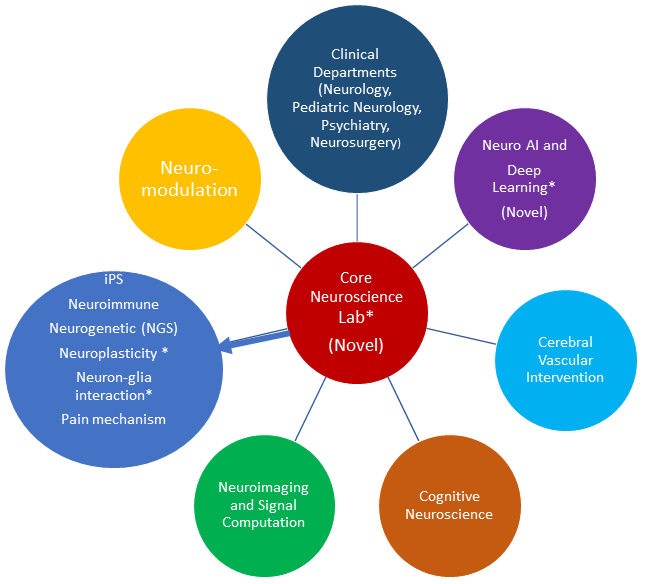Neuroscience and Brain Disease Center
It will be lots of Einsteins coming together to build a brain.
─ Michell Waldrop, Nature 2012
Background
The nervous system is the most important yet the most puzzling system of humans and other animals. It was Alcmaen of Croton (500 BC) who first proposed the idea that brain plays a central role in the controlling of the body and thought. The term "Neurology" was first introduced by Thomas Willis (1621-1675) about 350 years ago, establishing the flourishing field of neuroscience in research and medicine.
Driven by the immense demands of health care, the exploration of the fundamental biology of the human brain has emerged. With the development of neurophysiology and functional neuroimaging, the concept of connectomes among different brain regions has been rising fast in the past few years. Thanks to the advancement in experimental neuroscience in the past decade, it is now possible to interrogate the functional operation of the nervous system at cellular or neural circuitry levels. However, profound mysteries within the brain still exist. It seems that our brain is too simple to understand our brain. Filling the gap of knowledge is critical for clinical advance to treat many unsolved neurological disorders.
Neurodegenerative diseases such as Alzheimer's disease, Parkinson's disease, and amyotrophic lateral sclerosis affect tens of thousands of people. Current medical interventions have only limited effects, thus it is difficult to cure or to postpone the progress of these diseases. The missions of the Neuroscience and Brain Disease Center is to integrate the basic and clinical research of neuroscience for further understanding and management of unresolved neuropsychiatric diseases as well as basic operation of nervous system.
Main mission
- Focus on both basic and clinical neuroscience research
- Accelerate the translational studies in the field of neuroscience and the collaboration with clinical medicine, facilitate the clinical trails, innovation, and industrial connections
- Study the new technology or theraputic treatments for neuroscience to provide the advanced medical cares
- Improve the incorporation between the departments and research fields of CMU, interactions with other schools and international facilities, and the recruitment of international talents
- Provide the suggestions of neurological disorders to the goverment and other facilities and processs the projects from these facilities
Aim
To incorporate the state of art technologies into the current research and clinical investigations of neurological field targeting the leading diseases including neurodegenerative diseases (i.e. Parkinsonism, movement disorders, stroke) and cognitive-behavior disorders (i.e. Schizophrenia, and depression). Interdisciplinary research program incorporating clinical, neuroimaging, neuromodulation, cognition, and basic research will be formed. The team for each disease entity will be established and operated continuously.
Perspectives
- Build a novel integrated research center encompassing clinical-translational-basic elements in CMU and CMUH to target the unmet medical issues of major neuropsychiatric diseases and to unravel fundamental neuroscientific myths.
- Cultivate next generation physician scientists and neuroscientists to establish an eternally running neuroscience research system.
- Generate high-impact Papers from Happy and merry hearts, Patents with flourish Harvests, Products of Help, and have Patients Healed.
Constructive Elements of the Center (Fig. 1)
 The Center will encompass 7 Elements: Core Neuroscience Lab*, Neuromodulation, Clinical Departments, Neuro AI*, Stroke, Neuroimaging and Signal computation, and Cognitive Neuroscience. These seven Elements will connect and support to each other. (The symbol * means that the Element will be newly constructed.)
The Center will encompass 7 Elements: Core Neuroscience Lab*, Neuromodulation, Clinical Departments, Neuro AI*, Stroke, Neuroimaging and Signal computation, and Cognitive Neuroscience. These seven Elements will connect and support to each other. (The symbol * means that the Element will be newly constructed.)
